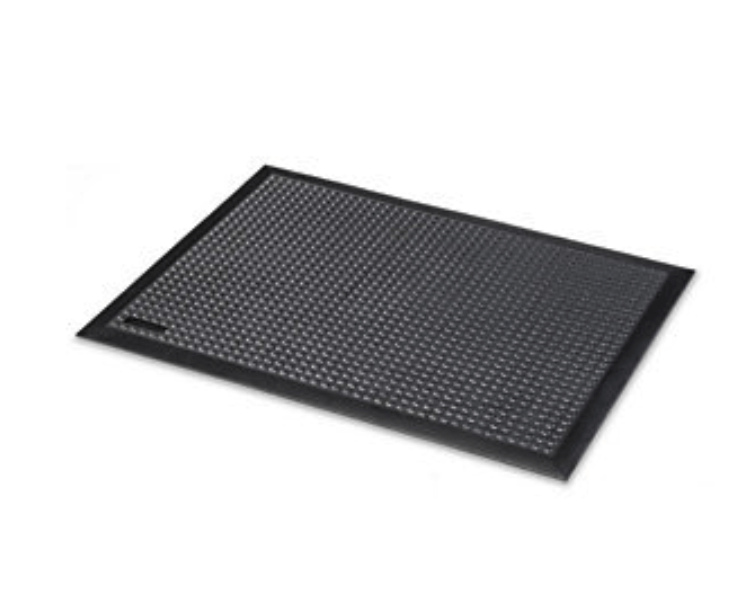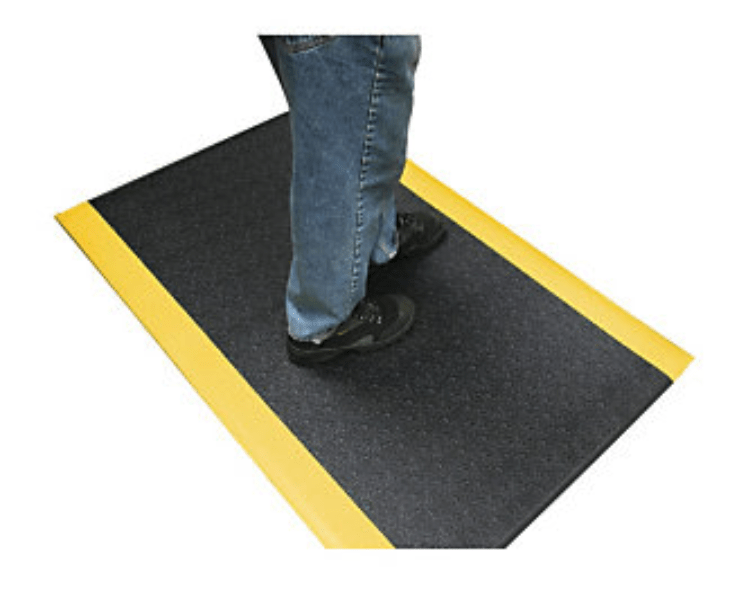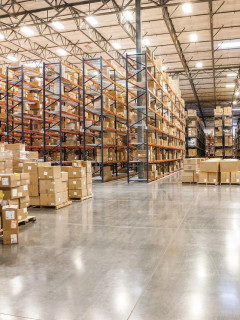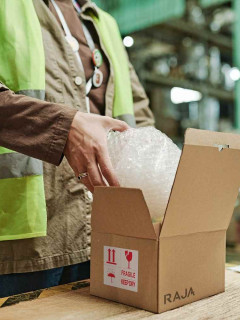Musculoskeletal problems, also known as Musculoskeletal Disorders (MSDs), are the main problems faced by logistics handlers. If they are caused by poor posture, the risks are multiplied if your operators are not properly equipped! To effectively reduce the risk of MSDs, the installation of anti-fatigue mats in your warehouses is essential.
49% of handlers work in a standing position for more than 20 hours a week – study by the French National Institute for Research and Safety (INRS)
It is therefore not surprising that the sameINRS recommends the use of anti-fatigue mats.
- Indeed, by adopting a static or semi-static posture, your order pickers are exposed to joint and muscle pain in the lower limbs.
- Combined with quality personal protective equipment, an industrial anti-fatigue mat can drastically reduce this pain and effectively prevent the onset of musculoskeletal problems at their workstation.
aujourd’hui, nous vous proposons un guide qui vous permettra de sélectionner votre tapis antifatigue en fonction de l’environnement de travail, ainsi que des tâches effectuées par vos opérateurs.
Cet article a été mis à jour en février 2021.
Tapis antifatigue : définition
Qu’est-ce qu’un tapis antifatigue ?
Les tapis antifatigue sont des équipements ergonomiques à installer sur votre lieu de travail, qui aident vos opérateurs à conserver leurs pieds et leurs jambes en bonne santé. Ils sont particulièrement préconisés dans le cas où vos ouvriers passent de longues heures en position debout.
Comment fonctionne un tapis antifatigue ?
De par leur conception, ces tapis industriels incitent vos préparateurs de commande à maintenir leurs pieds en mouvement, y compris lorsqu’ils effectuent un travail statique. Grâce à ces petits mouvements, ils évitent l’apparition de douleurs en station debout prolongée (mal de dos, problèmes au niveau de leurs articulations ou des
lombaires
- Blood circulation;
- Shock absorption;
- Reduction of fatigue due to working in a standing position.
how do you choose an anti-fatigue mat?
For an anti-fatigue mat to comply with the INRS recommendations, and for it to really benefit the well-being of your employees, it must be adapted to your activity. You must also take into account the surface area and the layout of the different areas of your supply chain. To respond effectively to this problem, manufacturers have divided their range into two types of products: tiles and solid mats.
Mats or tiles?
Protection mats can be divided into two main categories: solid mats or interleavable tiles
- The former are very easy to install, ready to be integrated directly into the various work areas and are easily transportable.
- The tiles are designed to fit together like gratings , creating customised spaces ofnon-slip material. This format is recommended for enclosing work areas, especially in corners, and for use in the smallest of warehouses where there is a lack of floor space.
today we will discuss your choice of anti-fatigue mats.
Cushion Trax NOTRAX anti-fatigue mat
The reference in the warehouse!
Technical characteristics
- Thickness: 14.3 mm ;
- Weight: 6.5 km /m² ;
- Anti-slip matting: complies with DIN51130, classification R10 ;
- Fire classification Bfl-S1 and conforms to DIN4102
the advantages of this mat
- Anti-fatigue, this mat allows pickers to better distribute their weight between the left and right foot and improves musculoskeletal comfort for operators working in a standing position.
- Highly resistant to wear and tear and chemicals, the mat is also slip-resistant, and with a diamond-point vinyl surface, the colour combination effectively delineates the safety zone and meets OSHA regulations.
- This mat has been tested and certified by the National Floor Safety Institute.
the high performance anti-fatigue mat
- Ergonomically developed, the SkyStep™ uses the power of air, the mat has been designed to adhere to the floor in prevention of slipping while the air is trapped in its cells.
the combination of its air pockets and the strength of the rubber gives a supreme feeling of comfort while making the mat lightweight
- The bubbled surface provides secure support and has an optimal ergonomic effect for jobs requiring standing work.
- Made from high quality natural rubber for maximum durability and excellent comfort in standing positions.
technical characteristics
- Thickness: 13 mm;
- Weight: 10 kg/m²;
- Single-layer matting, grainy surface;
- Made of anti-slip materials: conforms to EN13552, classification R9;
- Fire classification: DIN4102
- Made of recyclable materials (REACH compliant)
the advantages of this mat
- This anti-fatigue anti-slip mat is a real personal protection tool, with enhanced performance thanks to its unique ergonomic design, which reduces worker fatigue and increases safety.
- In addition, this industrial mat has wide, coloured borders integrated on all four sides to prevent tripping and improve its durability.
the economical anti-fatigue mat
Technical data
- Thickness : 9 mm ;
- Weight: 3.27 kg /m² ;
- Non-slip: conforms to EN13552, classification R10.
- Fire classification: DIN54332 (B2)
the advantages of this mat
- Specially designed to reduce fatigue caused by prolonged standing, this anti-fatigue mat greatly improves the musculoskeletal comfort of operators.
- This floor mat also has a large non-slip surface to ensure the safety of your workers.
The NOTRAX fine-ribbed workshop mat
Ideal for irregular areas and/or spaces where your employees will not remain static for too long (if this is the case, prefer a model above). It is in fact an alternative to tiles.
Technical characteristics
- Thickness : 3 mm ;
- Weight: 3.3 kg /m²;
- Loose laying or glued.
the advantages of this mat
- This anti-fatigue anti-slip mat is also highly resistant to wear and tear and chemical products, and its design makes it easy to cut and adapt to your different work areas, like a real floor covering.
- It is easy to cut (lengthwise).
- This workshop mat can be used not only on the floor, but also for other protection needs, especially near machines, where falling objects are common.
See the product sheet bonus: and if the configuration of the picking station allows it, think of the height-adjustable sit-stand stool, which allows teams to release muscular tension for a few minutes in a seated position. Whatever
bonus: and if the configuration of the picking station allows it, think of the height-adjustable sit-stand stool, which allows teams to release muscular tension for a few minutes in a seated position. Whatever
your needs and the configuration of your warehouses, you now know how to choose an anti-fatigue mat. This equipment should not be taken lightly, and greatly improves the well-being of your order pickers at work
BONUS: Some other equipment to reduce the risk of musculoskeletal problems
as
you have seen, anti-fatigue mats are a key piece of equipment for limiting the risk of musculoskeletal problems in the warehouse.
However, the occupational risks associated with MSDs are not only linked to your operators’ prolonged standing. Many other logistics activities can trigger this type of occupational illness and have various impacts on the health of your employees: concerns about the spine, the rachis, the wrist, the knee, the lumbar vertebrae, carpal tunnel syndrome, and so on…..
If it is crucial that you take an in-depth look at the organisation of work and working conditions in your warehouse, don’t be afraid to equip yourself with the right anti-MSDs equipment:
- Optimised and ergonomic packing stations: By putting the key tools for packing your parcels directly at the disposal of your operators, you reduce the strain on certain parts of the body, and improve health and safety during the packing phase
- Equipment to facilitate handling: Manual handling is one of the logistics activities that cause musculoskeletal problems, so make sure you choose constant level trolleys, rollers or pallet trucks if necessary
- A wrapping machine: This machine allows operators to avoid manual palletising, which causes rotator cuff (shoulder) problems.
key points to remember
- On average, pickers spend more than 20 hours a week standing;
- The use of an anti-fatigue mat can encourage movement and reduce the pain associated with static positions.
- Opting for an anti-fatigue mat is an effective way of preventing the onset of musculoskeletal disorders (MSDs). By not skimping on quality, you can avoid sick leave and all the additional costs associated with the interim.


















